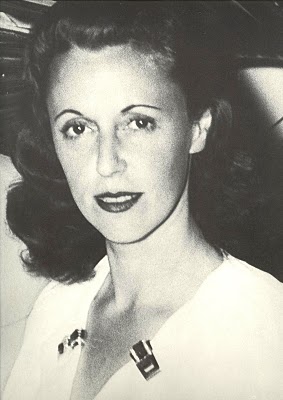The Piano Starts Here series continues Wednesday June 5th 2013 with “Music for the Baroness”. Performers for the evening include Dawn Clement, Ryan Burns, Josh Rawlings and Tim Kennedy. Hosted by Wayne Horvitz.
Piano Starts Here has always featured pianists in a solo format. For the “Music for the Baroness” performance each pianist will perform with The Sonny Clark Memorial Sextet, featuring Al Kieth, Craig Flory, Geoff Harper, Andy Roth and Steve Moore.
Tickets for Piano Starts Here: Music for the Baroness are available now from Stranger Tickets. $7 advance and $10 at the door
In the entry below, David Kastin, the author of “Nica’s Dream: The Life and Legend of the Jazz Baroness,” highlights some the two-dozen tunes that have been written for Pannonica (Nica) de Koenigswarter by a couple of generations of jazz greats.
For more information on David Kastin please visit the Nica’s Dream Facebook Page.
It was early in the research process for my biography of Nica. Having already plowed through all the available secondary sources, I sent out a batch of letters and e-mails to musicians and jazz writers soliciting their recollections of the “Jazz Baroness.” A few days later, a little after 11 p.m. as I was drifting off to sleep, the phone in my Brooklyn apartment jolted me awake: “Hello, David?” a laid-back voice inquired, “This is Horace Silver.”
Oblivious to the three-hour time difference from the Malibu, California address to which I’d recently mailed my letter, it turned out Horace was in the mood to reminisce. Not wanting to interrupt – to explain that I didn’t have my list of questions at hand (or the tape-recorder I’d planned on using) – I managed to make my way to my desk, find a notebook and pen, and began scribbling down his wistful memories of Nica, circa 1956…
By the time she arrived in NYC in the early 50’s, Nica had already acquired a formidable backstory. Born in 1913 into the English branch of the Rothschild family, she’d grown up in the fairytale splendor of London mansions and vast country estates. In 1935, the 22 year-old heiress (and avid aviatrix) took a solo hop across the English channel where she met her future husband, the Baron Jules de Koenigswarter, a fellow pilot and member of the French Jewish aristocracy. Following a whirlwind courtship, the newlyweds settled into a 17th century chateau outside Paris and started a family. When the Nazi’s invaded a few years later, they both joined the Free French Forces in North Africa, where Nica served as a translator and ambulance driver. Following the war, Jules, a war hero (and recipient of the Croix de Guerre), became a diplomat, and it was during his stint as Ambassador to Mexico that the Baroness made the decision to escape what had become a dysfunctional relationship.
After acquiring a Rolls Royce convertible and a suite in the elegant Stanhope Hotel, Nica became a fixture in New York’s midcentury jazz scene. She also became a source of material aid and comfort for musicians who were either strung out, or simply down on their luck, and her Stanhope suite became a 24-hour jazz salon where musicians could hang out and spin records on her state-of-the-art hi-fi. Recalling his own times chez Nica, Horace Silver recalled with a ripple of soft laughter, “She had a huge record collection, and Doug [Watkins, the bassist for the Jazz Messengers] and I made a point to visit around dinner time, because she always invited us to eat. We ordered filet mignon from the restaurant downstairs, and the waiters wheeled the meal in on a trolley and served it to us.” As I discovered later, she’d also been a generous patron to the newly-formed Messengers (which Silver had just co-founded with Art Blakey), buying the band a couple of sets of matching suits, and for Blakey, a Cadillac, so he could get them to gigs in style.
Before long, musicians began to repay her kindness in one of the only ways they could – by writing compositions in her honor, and Horace Silver’s soulful, Latin-tinged classic, “Nica’s Dream” was the first. As Silver explained it in our conversation, “She loved the music, and she loved the musicians,” and these tunes were “a tribute to her, because she was so good to us.” Later, when it came to choose a title for my book, I would appropriate the name of Silver’s tune, which for me, conjured up the romantic quest at the root of her life and legend.
Another member of Nica’s inner circle, the under-appreciated pianist, Freddie Redd, also made his contribution to the Nica canon, “Nica Steps Out” (a lyrical melody wrapped in an intricate bebop line) in honor of all the nights that they’d hit the clubs, sip Chivas Regal (“that was her favorite”), listen to records at the Stanhope and talk till dawn. “Everybody loved Nica,” Redd told me in our interview. “I mean, she was irresistible! We needed somebody like her. She gave us so much assistance and respect. It was wonderful.”
Of the two-dozen compositions dedicated to “the Baroness” (as she was affectionately-dubbed by New York’s bebop pioneers), each seems to suggest a different facet of her complex persona. Gigi Gryce’s “Nica’s Tempo” – by turns brash and reflective – evokes her mercurial spirit, while the sultry swing of Kenny Drew’s “Blues for Nica” captures her earthy sensuality; the spare, melodic beauty of Kenny Dorham’s “Tonica” reflects her old-school elegance, and the hipster strut of Sonny Clark’s “Nica (a.k.a. Royal Flush)” her quintessential cool.
Of course, of all the jazz greats she befriended, her thirty-year relationship with Thelonious Monk was the most profound, and the haunting ballad he wrote for her in 1956, “Pannonica,” remains one of the most beloved standards in the jazz repertoire. Prior to recording the tune with a band for his Riverside LP, Brilliant Corners, Monk performed a solo version for Nica that she documented on her reel-to-reel tape recorder. In an unusual gesture, the usually taciturn composer offered a spoken introduction to the tune that alludes to the story behind her unusual name: “It was named after this beautiful lady here…I think her father gave her that name after a butterfly he tried to catch. I don’t think he caught the butterfly.”
When Jon Hendricks, the songwriter and vocalese master, first met Nica at the Five Spot Cafe during one of Monk’s early gigs, he quickly saw past her glamorous image (the fur wrap, cigarette holder and silver flask). “She understood what culture is, and so she approached our culture in that way,” Hendricks explained when we spoke in his spacious New York apartment. “To her, Thelonious and Bird were not just ‘hip jazz musicians,’ they were great cultural artists, and she treated them that way. A few years later, Hendricks expressed his feelings for her in a set of lyrics he wrote for Monk’s “Pannonica.” Taking a cue from the entomological source of her exotic name, he titled his song, “Little Butterfly:”
Delicate things, such as butterfly wings,
poets can’t describe, ‘tho they try.
Love played a tune
when she stepped from her cocoon.
Pannonica, lovely, lovely, little butterfly.
Over the decades, many others would also try to capture her intangible essence in words or music, but just like that elusive butterfly, she continued to evade every attempt to pin her down. Nica died in 1988, and in a final gesture to her adopted city – and to the musician she loved and admired more than any other – she instructed her children to scatter her ashes in the Hudson River, ’round midnight.
Some other Nica Tunes:
“Thelonica” (Tommy Flanagan), “Inca” (Barry Harris), “Theme for Nica” (Eddie Thompson), “Nica’s Day” and “995 5th Ave” [the address of the Stanhope Hotel] (Wayne Horvitz), “Nica’s Gift” and“The Name is Nica” (Joel Forrester) and “Where is Pannonica?” (title of a 2009 CD by Andy Milne and Benoit Delbecq).

Terrific article. I am writing a book that includes the contributions of Nica to jazz. She was such an important figure in jazz patronage.
This is a beautiful story, I don’t even know how I got to this page, i started reading and couldn’t stop. Interesting enough, I met and spent time with Nicas grandson, STEVEN De KOENIGSWARTER ROTHCHILD, Yanka’s son, he mentioned some of this grandmother’s stories to me in 2022. Steveb loved his grandmother, in a sense, she actually saved his life. Thank you for taking the time to write this beautiful history about Nica. I used to DJ & hang around the city clubs around 1983 when I was of age, I wish I would’ve met her. I will leave it right there. I’ll always think that maybe I did run into her. Sincerely, Peter Y Martin